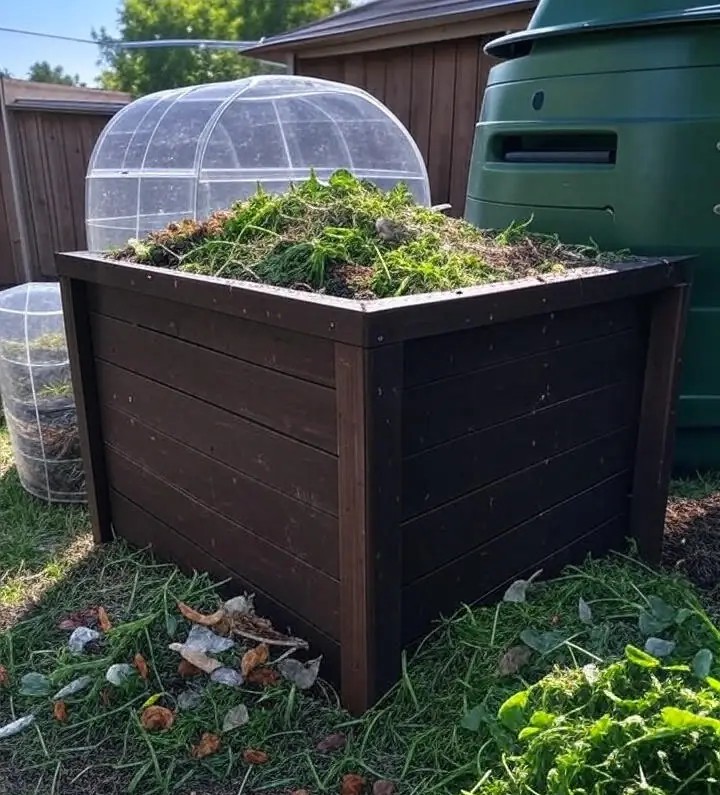The Four Essential Ingredients for Great Compost
Every composter relies on a balance of four elements to support microbes that do the hard work:
- Carbon-rich materials (Browns): Dry leaves, twigs, shredded cardboard — they bulk up the pile, aid airflow, and prevent it from getting too wet.
- Nitrogen-rich materials (Greens): Fruit and veggie scraps, grass clippings, and other green waste — these feed microbes and generate heat for decomposition.
- Water: Keep the pile moist like a wrung-out sponge.
- Air: Oxygen is vital for an aerobic process; it prevents odours and speeds decomposition.
Choosing Your Composting Method: Compost Bin vs Worm Farm
Your choice depends on your space and the type of waste you produce:
- Backyard composting: Ideal for those with a yard. Use a compost bin or compost tumbler to break down kitchen scraps and green waste like leaves and grass.
- Worm composting (vermicomposting): Perfect for smaller spaces. Using worms for compost in a worm farm compost system can be done indoors or on a balcony. It’s odour-free and produces highly concentrated compost.
Communities are also offering local drop-off programs for food scraps and green waste if home composting isn’t an option.
Backyard Composting Step-by-Step
What to Compost (and What to Avoid)
| Category | Examples |
|---|---|
| Greens / Nitrogen-rich (including green waste) | Fruit and veggie scraps, grass clippings, coffee grounds, paper tea bags |
| Browns / Carbon-rich | Dry leaves, twigs, shredded cardboard, shredded paper (non-glossy) |
| Avoid | Meat, fish, dairy, fats/oils, cooked food in large quantities, herbicide-treated plants, aggressive weeds, pet waste, glossy paper, waxed cardboard |
Building Your Pile
- Collect materials: Keep “greens” in a container indoors and stockpile “browns” outside.
- Choose space & bin: Pick a well-drained, accessible spot. Use compost bins, compost tumbler, or an open pile.
- Prepare materials: Chop tough scraps; break up large twigs.
- Layer the pile: Start with 10–15 cm of bulky browns for drainage. Alternate greens and browns like lasagne. Aim for 2–3 parts brown to 1 part green. Cover fresh food scraps with 10–20 cm of browns to prevent odours and pests.
- Maintain: Keep moisture like a wrung-out sponge. Turn occasionally with a garden fork. Core temperatures should reach 55–70°C to kill pathogens and weed seeds.
- Troubleshoot:
- Too dry → add water and turn.
- Smelly → too wet, add browns and aerate.
- Not heating → add greens and turn.
- Harvest: Compost is ready in 3–5 months (or up to a year if left unattended). It should be dark, crumbly, and smell like fresh soil. Cure for 4 weeks if needed.
Worm Composting (Worms Compost / Worm Farm Compost)
No yard? Worm farm vs compost is perfect for apartments or small spaces. Worms for compost can process kitchen scraps and green waste, producing both solid and liquid fertiliser.
What You Need
- Location: Indoor temperature 15–25°C, or shaded and insulated outside.
- Bin: Purchase a wormery or DIY using two plastic storage bins (inner bin with air and drainage holes, outer bin to catch liquid).
- Worms: Red wrigglers (Eisenia fetida) — don’t use garden or bait shop worms.
- Bedding: Shredded newspaper, cardboard, dry leaves. Soak and wring to sponge consistency.
- Food: Fruit & veggie scraps, coffee grounds, crushed eggshells, and small amounts of green waste. Avoid meat, dairy, oils, citrus in large quantities, and pet waste.
Setting Up & Maintaining
- Fill bin halfway with moist bedding and a handful of soil.
- Add worms; they’ll naturally burrow.
- Feed small amounts, always covered by 5 cm of bedding.
- Harvest after 3–6 months. Solid castings are ready immediately; liquid fertiliser (“worm tea”) should be diluted 1:10 with water.
Using Your Homemade Compost
Using your homemade compost is the final step of the cycle — solid compost enriches your soil, while diluted worm tea gives your plants an instant nutrient boost.
- Compost / Worm farm compost: Mix into garden beds or potting mix to improve fertility and soil structure.
- Worm tea: Dilute and feed plants for a nutrient boost.
Conclusion: Happy Composting!
Composting is simple, rewarding, and connects us to nature’s cycles. Whether you have a large backyard or a small balcony, there’s a method that works for you. With your kitchen compost bin, worms for compost, compost tumbler, and the right balance of green waste, your scraps become valuable resources for a thriving garden.


